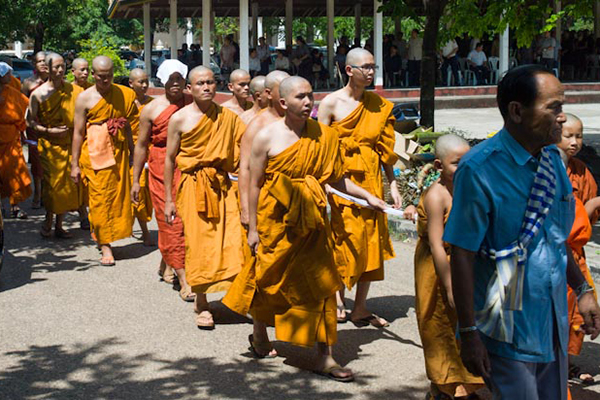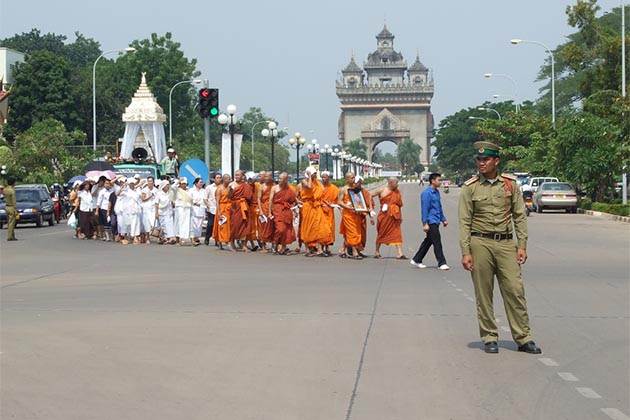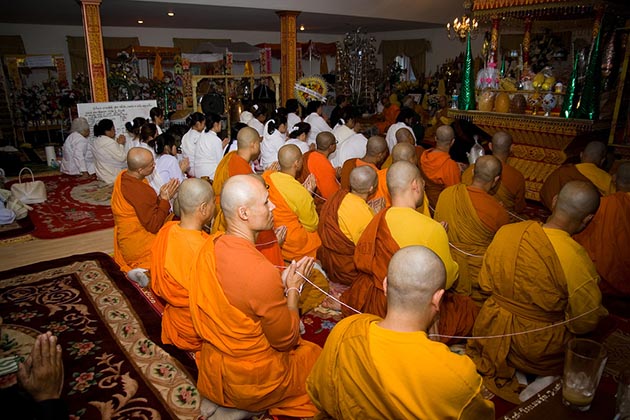Laos dead ceremony or funeral ceremony in Laos is largely conducted in accordance with Buddhist customs. Following the death of natural causes, the body is kept at the home of the deceased for one to three days, during which time villagers come to pay their respects and assist the family of the deceased in what is a sort of long, continuous, low-key wake. The body is usually cremated but in some cases is buried.
How is Laos Dead Ceremony Held?
The procession starts with the coffin of the deceased arriving at the crematory site, led by Buddhist monks. White-robed nuns follow the monks and together, as they walk in a line, hold a ceremonial white cloth. Family members walk behind the nuns, while the funeral car holding the deceased’s coffin and friends of the deceased follow closely behind. The coffin is covered by a funeral tower, which was taken apart upon arrival.
Then the coffin is carried to the raised gravesite or pyre. Monks and family members circle the site with the coffin several times before the coffin is laid on top of the raised gravesite or pyre. Monks and family members are dripping juice of fresh coconut into the coffin. A picture of the deceased is placed on the mam, flowers donations surrounding it. On three sides of the mam family members and dignitaries, the monks and nuns, and the general public are seated. The funeral is ready to begin. The white ceremonial cloth that nuns were holding during the procession is tied to one of the corners of the mam. It is then placed in front of the female family members and nuns, who sit adjacent to the mam.
Family members then offer candles and flowers to the deceased. The ceremony ends with the lighting of the pyre by female family members. They also throw candies at children. When the mam is burning it becomes clear, that a lot of firewood is stacked underneath the mam to make sure, the body is burned. Only a few monks remain to collect the ashes later on. Looking at a wooden door of the temple it becomes clear, that these funerals rites are deeply rooted in Buddhism.
People who come to the funeral, normally offer some money, some rice with Thoup, Tian, and flowers to show respect to the dead. After the funeral is over, this money and stuff belong to relatives, parents of the dead person. Relatives and friends of the dead person will be attended by a monk or nun on a day of cremation. After the cremation, it is time to collect the bones in the cemetery and put them into an urn, and move them to a small stupa in the temple. The family of the dead must invite monks to pray in order to invite the soul of the dead person to the urn in the stupa (which is essentially the same as a gravestone).
Traditions & Taboos in Laos Funeral Ceremony
Traditions of Laos Funeral Ceremony
- During the funeral, don’t kill any animals
- Foods can’t bring in there
- Don’t play loud music, dance, or sing. Means that it’s not a kind of music of entertainment during the funeral, however after the cremation, you can do that
- If death is a sudden or accidental death, the body can’t in the house
- In a Buddhist funeral, the body will be kept in the temple and must be buried as soon as possible
- Traditionally, the people who come to the funeral will stay overnight to keep the cousin of death person a company. They can play with cards, watch videos, and chilling at the night.
The Taboos in Laos Dead Ceremony
- Don’t take food at the “heuan dee”. The Lao consider that the deceased has moved on and beyond and in a sense, relieved of their life’s sin that they have repaid in their lifetime.
- You can’t cook noodle dishes because the noodle is considered as strings that may bind the deceased soul to their former life and the things they left behind.
- Wash your hands with blessed water before the funeral home
To get more about information about Laos Tour as well as Laos culture, click here to get more detail.



